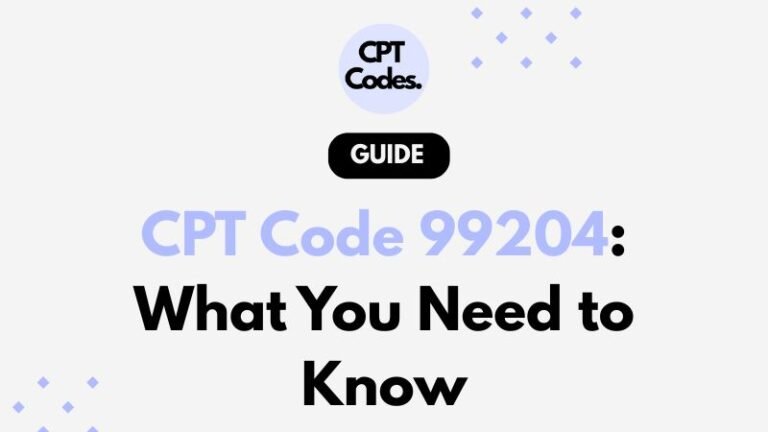If you’re dealing with medical billing, coding, or practice management, understanding CPT 99204 is essential.
What Is CPT 99204?
- Definition: CPT 99204 is an evaluation and management (E/M) code used when a new patient visits an office or outpatient setting.
- Time Frame: It typically represents 45–59 minutes of total time spent on that date (both face-to-face and non–face-to-face work).
- Complexity: It involves a moderate level of medical decision making (MDM) or meeting other criteria (history, exam, or time).
In short: it’s used for new patients who require a detailed evaluation and moderately complex medical decision making.
When Should You Use CPT 99204?
You should consider using 99204 when the following conditions are met:
- The patient is new (hasn’t had a professional visit with your group in the same specialty within the last 3 years).
- The medical decision making is moderate complexity, or the total time spent is 45–59 minutes.
- The history and physical examination are comprehensive and clearly documented.
- The nature of the problem is moderate-to-high severity, requiring more in-depth management or testing.
If the visit is simpler or takes less time, consider using CPT 99203 instead.
How to Document CPT 99204 Properly
Accurate documentation is your best defense against audits and claim denials. Make sure you include:
History
- Document past medical, family, and social history (PFSH).
- Include a thorough review of systems (ROS).
- Clearly state the chief complaint and history of present illness (HPI).
Physical Examination
- Perform and record a comprehensive exam covering multiple systems or body areas.
- Use structured templates or bullet-point formats for clarity.
Medical Decision Making (MDM)
- Moderate complexity should reflect the number of diagnoses, risk levels, and data reviewed.
- Include relevant labs, imaging, medication changes, or specialist consultations.
Time-Based Coding
-
- When selecting the code based on time, ensure total time (45–59 minutes) includes only time personally spent by the provider.
Medical Necessity
- Explain why this level of service is appropriate.
- Connect symptoms, findings, and clinical reasoning to the care plan.
Common Mistakes to Avoid
- Overcoding without full documentation — Don’t select 99204 unless every requirement is supported.
- Incorrect patient status — Confirm it’s truly a new patient (not seen by your group in 3 years).
- Misuse of time — Count only provider time related to that specific encounter.
- Incomplete exam or review — Missing systems or sections can lead to downcoding.
- Weak medical necessity — Always show why the visit needed moderate-level attention.
Real-World Example
A 45-year-old patient presents with chest discomfort and a history of hypertension. The provider spends 50 minutes evaluating, reviewing records, ordering tests, adjusting medications, and documenting a multi-system exam. The decision-making is moderate due to medication management and follow-up care planning. This supports CPT 99204.
CPT 99204 vs Neighboring Codes
| CPT Code | Duration / Complexity | Use Case |
|---|---|---|
| 99203 | 30–44 min, low complexity | For new patients with straightforward issues |
| 99204 | 45–59 min, moderate complexity | For more involved new patient visits |
| 99205 | 60–74 min, high complexity | For complex cases requiring extensive decision making |
Choose the code based on how complex the visit was, not just time spent.
Tips to Reduce Claim Denials
- Use structured templates for consistent documentation.
- Perform regular internal chart audits to maintain compliance.
- Train providers on what justifies moderate complexity.
- Stay updated with payer-specific rules and documentation standards.
- When denied, appeal with notes that clearly justify the code level.
Key Takeaways
- CPT 99204 applies to new patients with moderate complexity and 45–59 minutes of provider time.
- Ensure all three pillars — history, exam, and MDM (or time) — are properly documented.
- Avoid overcoding and under-documenting.
- Regular training and audits keep your billing compliant and efficient.

